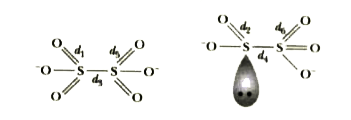Hybrid orbital with maximum p-character is
sp3d
sp3
sp
sp3d2
The correct Answer is:B
To determine which hybrid orbital has the maximum p-character, we will analyze the given hybrid orbitals: sp3d, sp3, sp, and sp3d2. We will calculate the percentage of p-character for each hybridization.
Step 1: Analyze SP3D Hybridization
- Participating Orbitals: 1s, 3p, and 1d = 5 orbitals
- P Orbitals: 3 (from 3p)
- Percentage of P Character:
Percentage=(Number of p orbitalsTotal number of orbitals)×100=(35)×100=60%
Step 2: Analyze SP3 Hybridization
- Participating Orbitals: 1s and 3p = 4 orbitals
- P Orbitals: 3 (from 3p)
- Percentage of P Character:
Percentage=(34)×100=75%
Step 3: Analyze SP Hybridization
- Participating Orbitals: 1s and 1p = 2 orbitals
- P Orbitals: 1 (from 1p)
- Percentage of P Character:
Percentage=(12)×100=50%
Step 4: Analyze SP3D2 Hybridization
- Participating Orbitals: 1s, 3p, and 2d = 6 orbitals
- P Orbitals: 3 (from 3p)
- Percentage of P Character:
Percentage=(36)×100=50%
Step 5: Compare the Percentages
- SP3D: 60%
- SP3: 75%
- SP: 50%
- SP3D2: 50%
Conclusion
The hybrid orbital with the maximum p-character is SP3, which has 75% p-character.
Final Answer
SP3 is the correct answer.
---
- Participating Orbitals: 1s, 3p, and 1d = 5 orbitals
- P Orbitals: 3 (from 3p)
- Percentage of P Character:
Percentage=(Number of p orbitalsTotal number of orbitals)×100=(35)×100=60%
- Participating Orbitals: 1s and 3p = 4 orbitals
- P Orbitals: 3 (from 3p)
- Percentage of P Character:
Percentage=(34)×100=75%
- Participating Orbitals: 1s and 1p = 2 orbitals
- P Orbitals: 1 (from 1p)
- Percentage of P Character:
Percentage=(12)×100=50%
- Participating Orbitals: 1s, 3p, and 2d = 6 orbitals
- P Orbitals: 3 (from 3p)
- Percentage of P Character:
Percentage=(36)×100=50%
- SP3D: 60%
- SP3: 75%
- SP: 50%
- SP3D2: 50%
The hybrid orbital with the maximum p-character is SP3, which has 75% p-character.
SP3 is the correct answer.
Topper's Solved these Questions
- CHEMICAL BONDING AND MOLECULAR STRUCTUREBOOK - NARAYNACHAPTER - CHEMICAL BONDING AND MOLECULAR STRUCTUREEXERCISE - CUQ (DATIVE BOND)
3 Videos
- CHEMICAL BONDING AND MOLECULAR STRUCTUREBOOK - NARAYNACHAPTER - CHEMICAL BONDING AND MOLECULAR STRUCTUREEXERCISE - CUQ (MOLECULAR ORBITAL THEORY)
7 Videos
- CHEMICAL BONDING AND MOLECULAR STRUCTUREBOOK - NARAYNACHAPTER - CHEMICAL BONDING AND MOLECULAR STRUCTUREEXERCISE - CUQ (VSEPR THEORY)
8 Videos
- CARBONYL COMPOUNDSBOOK - NARAYNACHAPTER - CARBONYL COMPOUNDSEXERCISE - LEVEL -VI
99 Videos
- CHEMICAL EQUILIBRIUMBOOK - NARAYNACHAPTER - CHEMICAL EQUILIBRIUMEXERCISE - Exercise -IV
33 Videos
Similar Questions
According to hybridisation theory, the % s-character in sp,sp2andsp3 hybrid orbitals is 50, 33.3 and 25 respectively, but this is not true for all the species. When θ is the bond angle between equivalent hybrid orbitals then % s and p-character in hybrid orbitals (when only s and p-orbitals are involved in hybridisation) can be calculated by the following formula :
cosθ=SS−1=P−1P
Q. Smallest OˆSO bond angle is found in :
View SolutionAccording to hybridisation theory, the % s-character in sp,sp2andsp3 hybrid orbitals is 50, 33.3 and 25 respectively, but this is not true for all the species. When θ is the bond angle between equivalent hybrid orbitals then % s and p-character in hybrid orbitals (when only s and p-orbitals are involved in hybridisation) can be calculated by the following formula :
cosθ=SS−1=P−1P
Q. Smallest OˆSO bond angle is found in :
View Solution
Knowledge Check
Hybrid orbital with least s- character is
Asp3dBsp2Csp3DspAccording to hybridisation theory, the % s-character in sp,sp2andsp3 hybrid orbitals is 50, 33.3 and 25 respectively, but this is not true for all the species. When θ is the bond angle between equivalent hybrid orbitals then % s and p-character in hybrid orbitals (when only s and p-orbitals are involved in hybridisation) can be calculated by the following formula :
cosθ=SS−1=P−1P
Q. Correct order of P−P bond length in the following compound is :AP2F4<P2(CH3)4<P2(CF3)4<P2H4BP2F4<P2(CF3)4<P2(CH3)4<P2H4CP2F4<P2H4<P2(CH3)4<P2(CF3)4DP2F4<P2(CH3)4<P2H4<P2(CF3)4According to hybridisation theory, the % s-character in sp,sp2andsp3 hybrid orbitals is 50, 33.3 and 25 respectively, but this is not true for all the species. When θ is the bond angle between equivalent hybrid orbitals then % s and p-character in hybrid orbitals (when only s and p-orbitals are involved in hybridisation) can be calculated by the following formula :
cosθ=SS−1=P−1P
Q. Correct order of P−P bond length in the following compound is :AP2F4<P2(CH3)4<P2(CF3)4<P2H4BP2F4<P2(CF3)4<P2(CH3)4<P2H4CP2F4<P2H4<P2(CH3)4<P2(CF3)4DP2F4<P2(CH3)4<P2H4<P2(CF3)4
The hybrid orbitals with 33.33% S-character are involed in the bonding of one of the crystalline allotropes of carbon. The allotrope is
View SolutionAccording to Bent's rule, more electronegative atom prefers to stay in that hybrid orbital which has less s-character and lone pair prefers to stay in that hybrid orbital which has more s-character.
Consider the molecules given below and answer the following question

Which of the following bond length order is correct?
View SolutionAccording to Bent's rule, more electronegative atom prefers to stay in that hybrid orbital which has less s-character and lone pair prefers to stay in that hybrid orbital which has more s-character.
Consider the molecules given below and answer the following question

Out of d1,d2,d3,d4,d5 and d6 which bond length is the maximum?
View SolutionHybrid orbitals could make
View SolutionAhybrid orbital has 25% s-character and 75% p-character. To which type of hybridization it belongs
View Solution
